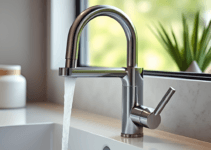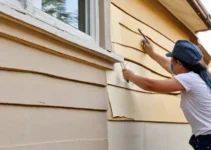Maintaining a clean oven is crucial for several reasons, both for functionality and health. A dirty oven can significantly impact the taste of your food. Residual grease and food particles can produce unpleasant odors, which can permeate your dishes, resulting in compromised flavors. Moreover, these residues can cause smoke, affecting the overall cooking environment.

Beyond affecting the taste, a dirty oven can reduce the efficiency of the appliance. Accumulated grime can hinder the oven’s heating elements, requiring more energy to reach desired cooking temperatures. This not only increases your energy bills but also prolongs cooking times. Proper maintenance ensures that your oven operates at peak efficiency, saving both time and money in the long run.
Please, read our post and do not forget to check our YouTube channel “Grig Stamate”:
https://www.youtube.com/@GrigStamate
You will find there, thousands of designing, furnishing, and decorating ideas for your home interior and outdoors.
Allow me to mention one of them:
Remodel Your Kitchen with These Creative Ideas | Interior Design Ideas #4 (video)
Another critical aspect is safety. A buildup of grease and food debris can become a potential fire hazard. According to the National Fire Protection Association (NFPA), cooking equipment is the leading cause of home fires, and dirty ovens are a significant contributor. Regular cleaning reduces this risk, providing a safer cooking environment.
Experts recommend cleaning your oven every three to six months, depending on usage. This frequency can vary; for example, frequent bakers might need to clean their ovens more often than occasional users. A clean oven not only enhances performance but also extends the lifespan of the appliance. Routine maintenance prevents wear and tear, ensuring that your oven remains in good working condition for years to come.
In addition to these benefits, regular cleaning can also contribute to a healthier home environment. Eliminating burnt-on food and grease can reduce the risk of exposure to potentially harmful substances. By integrating simple, non-toxic cleaning solutions like baking soda and soap into your maintenance routine, you can achieve a spotless oven without the need for harsh chemicals.
The Science Behind Baking Soda and Soap
Baking soda, or sodium bicarbonate, is a versatile and effective cleaning agent due to its unique chemical properties. As a mild alkali, baking soda can dissolve dirt and grease in water, making it an excellent option for cleaning tough stains in ovens. Its slightly abrasive nature helps to physically lift grime without scratching surfaces, ensuring the oven remains intact while thoroughly cleaned.
One of the key properties of baking soda is its ability to neutralize acids and bases, which can help eliminate unpleasant odors often found in ovens. When baking soda comes into contact with acidic substances, such as grease and food residues, a chemical reaction occurs, producing carbon dioxide gas. This reaction helps to dislodge and break down stubborn grime, making it easier to remove.
Soap, on the other hand, complements baking soda by acting as a surfactant. Surfactants are compounds that lower the surface tension of liquids, allowing them to spread and penetrate more effectively. This characteristic is particularly useful in cutting through oily residues that can be difficult to remove with water alone. The soap molecules surround the oil particles, breaking them up and suspending them in the wash water. This action not only facilitates the removal of grease but also ensures that the oven surface can be rinsed clean without leaving any residue.
The combination of baking soda and soap creates a synergistic effect, enhancing the overall cleaning power. While baking soda works on breaking down and lifting the grime, soap ensures that the loosened particles are easily washed away. This dual action makes the baking soda and soap mixture a potent solution for oven cleaning.
Scientific studies and expert opinions support the effectiveness of these agents. According to a study published in the Journal of Surfactants and Detergents, surfactants like those found in soap are highly effective at emulsifying oils and greases. Furthermore, the American Cleaning Institute highlights baking soda’s role in neutralizing odors and breaking down grease, making it a staple in household cleaning.
Step-by-Step Guide to Cleaning Your Oven with Baking Soda and Soap
Cleaning your oven using baking soda and soap is a straightforward and effective method that can restore its shine without the use of harsh chemicals. Here’s a detailed step-by-step guide to help you through the process:
Preparation
Start by gathering all necessary materials. You will need baking soda, liquid dish soap, water, a spray bottle, a sponge or soft cloth, a plastic spatula, and rubber gloves. Ensure the oven is completely cool before you begin to avoid any risk of burns.
Creating the Cleaning Solution
In a small bowl, mix half a cup of baking soda with a few tablespoons of water to form a thick paste. The consistency should be spreadable, so adjust the water amount as needed. Additionally, add a few drops of liquid dish soap to the mixture for enhanced grease-cutting power.
Applying the Solution
Remove the oven racks and any other detachable parts. Using a sponge or cloth, evenly spread the baking soda and soap paste over the interior surfaces of the oven, focusing on areas with visible grime and grease. Avoid applying the mixture to the heating elements. Let the solution sit for at least 12 hours or overnight for optimal results.
Scrubbing and Rinsing
After the solution has had ample time to work, don your rubber gloves and use a damp cloth or sponge to scrub the interior surfaces of the oven. For particularly stubborn spots, a plastic spatula can be used to gently scrape away the residue. Once the grime is loosened, use a clean, damp cloth to wipe down the surfaces, removing all traces of the baking soda and soap mixture.
Final Tips
Reinsert the oven racks and any other detachable parts once the interior is clean and dry. To avoid damage, never use abrasive tools or harsh chemicals during the cleaning process. Regular maintenance can help prevent the buildup of stubborn grime, making future cleanings easier and more efficient.
Maintaining a Clean Oven: Tips and Tricks
Maintaining a clean oven is essential for both its longevity and optimal cooking performance. After your initial deep clean with baking soda and soap, adopting a few practical habits can make a world of difference. Regular light cleanings, the use of oven liners, and immediate spill management are crucial strategies in keeping your oven in pristine condition.
First, establish a routine for light cleanings. Aim to wipe down the oven interior at least once a week, especially if you use it frequently. A simple solution of warm water and mild dish soap can effectively remove minor spills and grease. This regular maintenance prevents the accumulation of stubborn grime and makes future deep cleans less daunting.
Oven liners are another excellent tool for maintaining cleanliness. These non-stick mats can be placed at the bottom of the oven to catch drips and spills. They are easy to remove and wash, saving you from scrubbing the oven floor. Just ensure the liners are oven-safe and do not obstruct any vents.
Address spills immediately to prevent them from hardening and becoming more difficult to clean. When a spill occurs, allow the oven to cool slightly, then wipe it away with a damp cloth or sponge. For tougher residues, sprinkle a bit of baking soda on the spill before wiping it up. This natural ingredient is effective in breaking down grease and food particles.
In between deeper cleans, you can quickly freshen up your oven using simple and natural methods. A mixture of equal parts water and vinegar in a spray bottle works wonders. Lightly mist the interior, let it sit for a few minutes, then wipe it down. This not only cleans but also helps neutralize any lingering odors.
To keep your oven in top condition, consider following a maintenance schedule. Perform light cleanings weekly, use oven liners consistently, and address spills promptly. Every three to six months, carry out a more thorough deep clean using baking soda and soap. This balanced approach ensures your oven remains efficient and ready for all your culinary adventures.
Other related posts from our website:
https://howtobuildahouseblog.com/design-tricks-to-make-your-small-kitchen-look-larger/
https://howtobuildahouseblog.com/creating-positive-feng-shui-in-your-kitchen-7-things-to-avoid/
Thank you so much for your attention.
Stay tuned. We will upload many other amazing posts to our website and videos onto our YouTube channel.
Thank you so much.
for your time and attention.
Best Regards
See you to another post,


